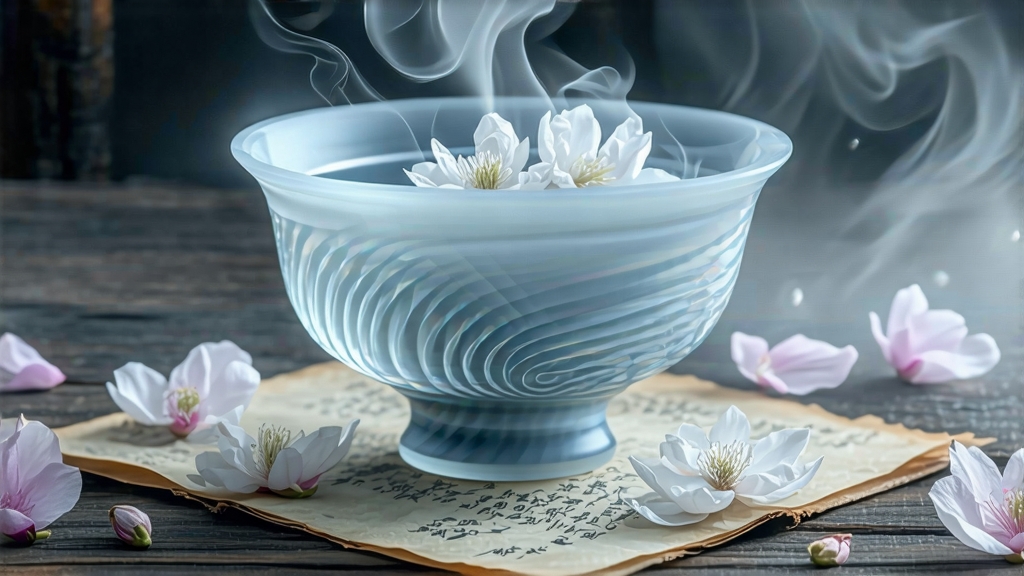
Among the six great families of Chinese tea, white tea is the least theatrical yet the most haunting: it is simply picked and allowed to rest, yet in that quiet interval the leaf composes a perfume no fire can coax from other varietals. Within this minimalist lineage, Bai Hao Yin Zhen—literally “White-Hair Silver Needle”—stands as the apex, the imperial concubine who speaks only in whispers. International drinkers often meet white tea first through airy bags labeled “silver needles,” but the authentic needle is a single, unopened bud, sheathed in microscopic trichomes that glint like frost under light. One sip of the genuine Fuding version is enough to retire the word “subtle” from one’s tasting vocabulary; what appears delicate is in fact concentrated moonlight, a cool luminosity that lingers longer than many reds.
History: from palace secret to moonlit export
Song-dynasty emperor Huizong (1082-1135) recorded in his “Daguan Treatise on Tea” that the finest tribute consisted of “white buds plucked before the Qingming festival, steamed lightly, pressed into cakes.” Those cakes vanished with the dynasty, but the buds remained in Fujian folk memory. By the late Ming, tea makers around Taimu Mountain abandoned roasting altogether, experimenting with long withering under pine-fired breezes. The new loose-leaf white tea travelled south to Canton where European buyers, mistaking the down for mould, nearly rejected the cargo—until the cup persuaded them otherwise. In 1891 the first chest labeled “Pekoe Silver Needle” reached London, and by 1910 it graced Harrods at triple the price of Keemun. Republican-era Fuding merchants still sealed each tin with rice-paper bearing a tiny crescent moon, promising that every bud had been plucked “between the hour of the hare and the hour of the dragon,” i.e. dawn.
Terroir: why Fuding tastes like starlight
Authentic Silver Needle is born inside a 200 km² core defined by Taimu Mountain’s granite spine and the East China Sea’s fog. Red-yellow lateritic soil, rich in quartz and depleted in nitrogen, forces the tea bush (Camellia sinensis var. sinensis, Da Bai cultivar) to hoard amino acids in its apical buds. At 200–500 m elevation, day-night temperature differentials reach 10 °C; the plant responds by thickening its pubescence, the “white hairs” that reflect ultraviolet and concentrate l-theanine. Sea-born clouds arrive each afternoon, slowing transpiration so that moisture retreats from the bud in millimetre increments, the botanical equivalent of a 24-hour slow-motion exhale. Move the same cultivar even 80 km inland and the buds grow longer, greener, less downy; the infusion becomes pleasantly grassy but loses the cool pear-blossom note that haunts the coastal original.
Plucking etiquette: one bud, no gloves
The picking window opens five days before Qingming and closes at Guyu—barely twenty mornings. Experienced pluckers use thumb and index finger only, snapping the bud downward so the tiny stem shears cleanly; nails are forbidden because they bruise the base, turning it ochre during withering. A full kilogram of fresh buds numbers roughly 18,000 pieces, all picked before 9 a.m. while dew still glimmers. Carriers wear bamboo baskets lined with banana leaf, never plastic, because the leaf breathes and the bud must not sweat.
Craft: the art of doing almost nothing
Silver Needle is the only famous tea whose processing steps can be recited on one hand: wither, sort, dry, rest. Yet each step is a meditation on moisture and air. Fresh buds are spread on bamboo trays 1.5 cm thick and placed inside a sun-warmed corridor whose windows face north; direct sun is taboo. For 36–48 hours the leaf loses water while polyphenol oxidase remains active at micro-level, generating tiny quantities of floral lactones without crossing into full oxidation. Every forty minutes the tea master lifts a tray, tilts it 30°, and fans the air with a palm-leaf paddle—an act called “inviting the wind.” When the bud’s moisture drops to 10 %, a final 20-minute bake at 40 °C locks the aroma. Unlike green tea’s kill-green